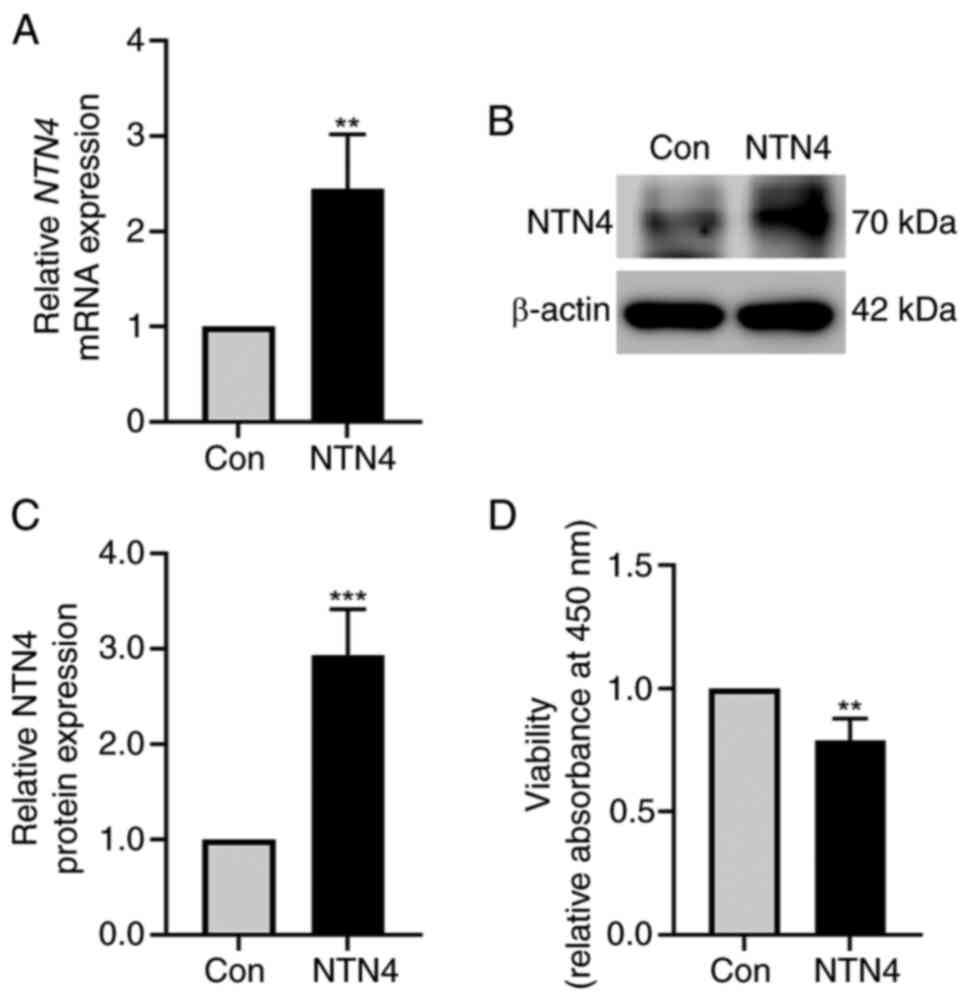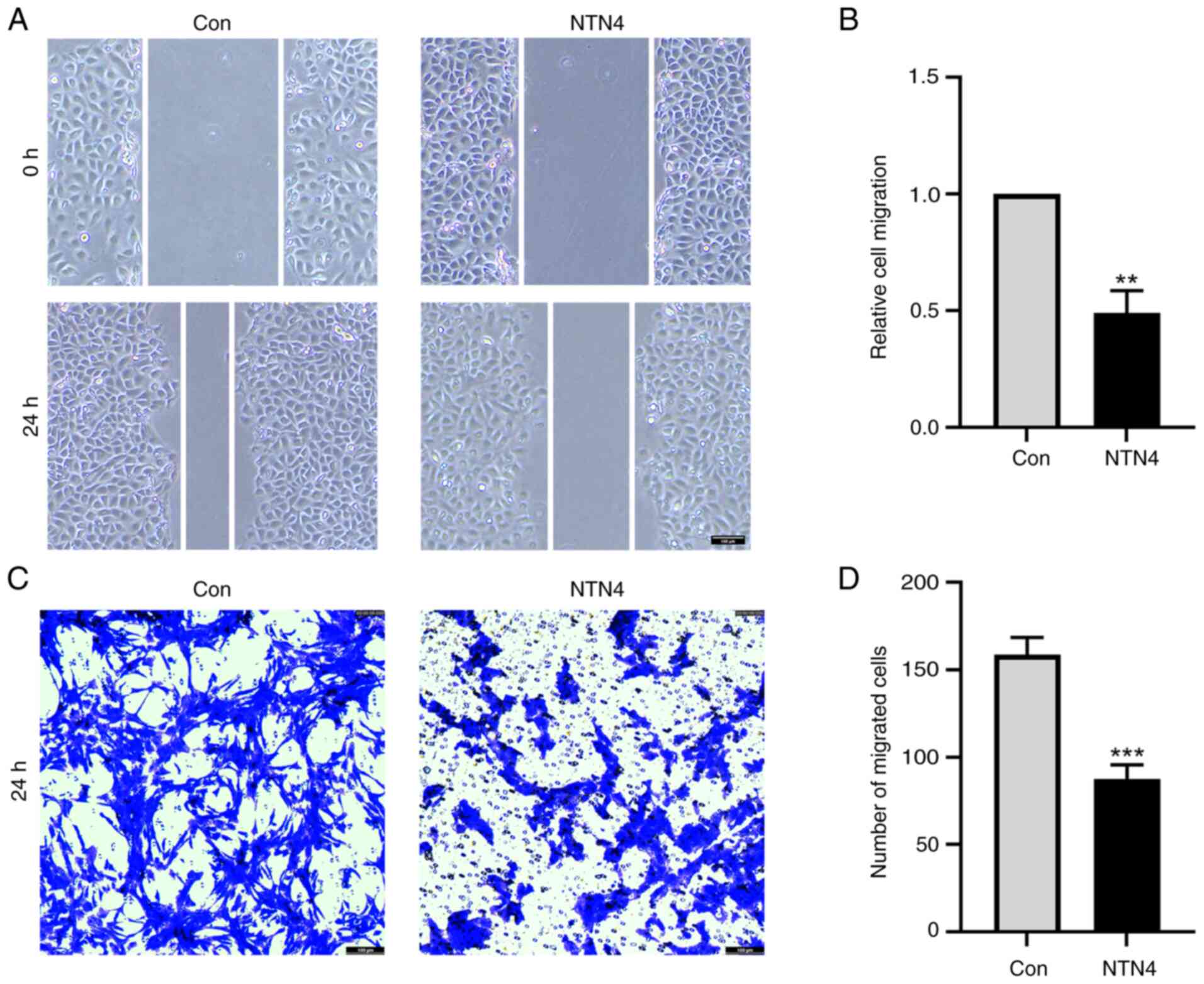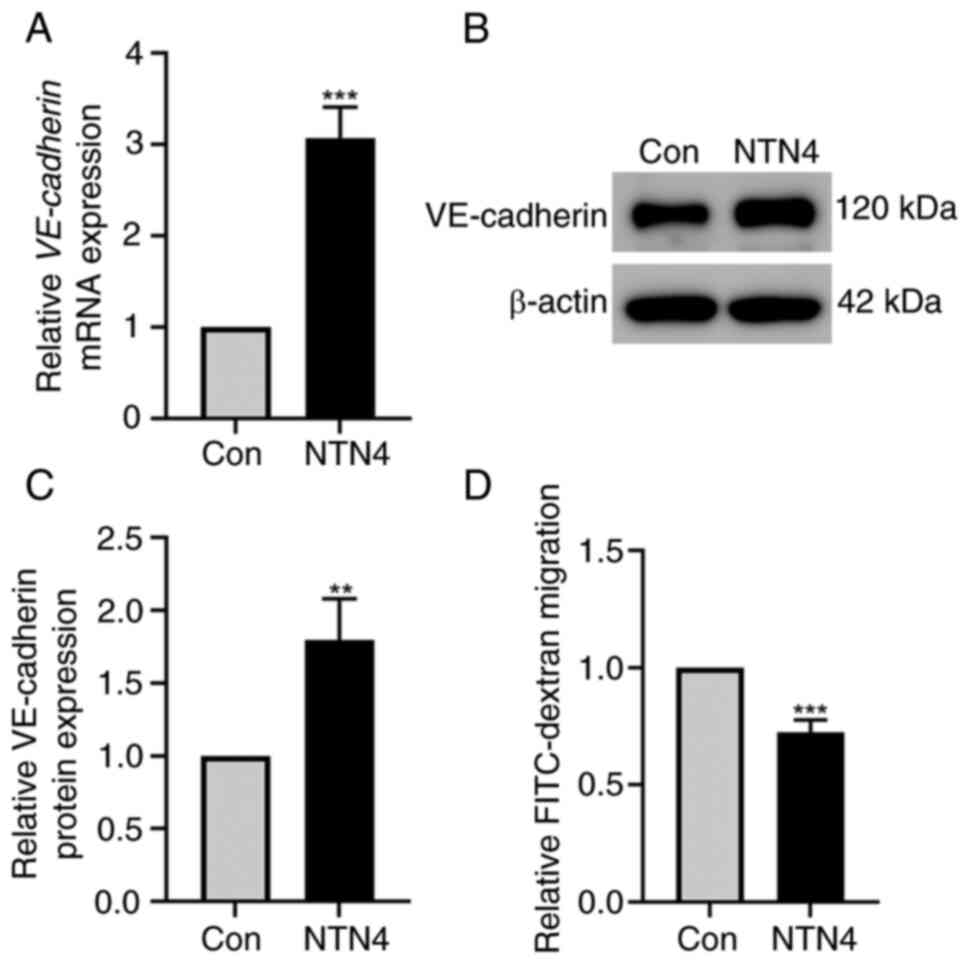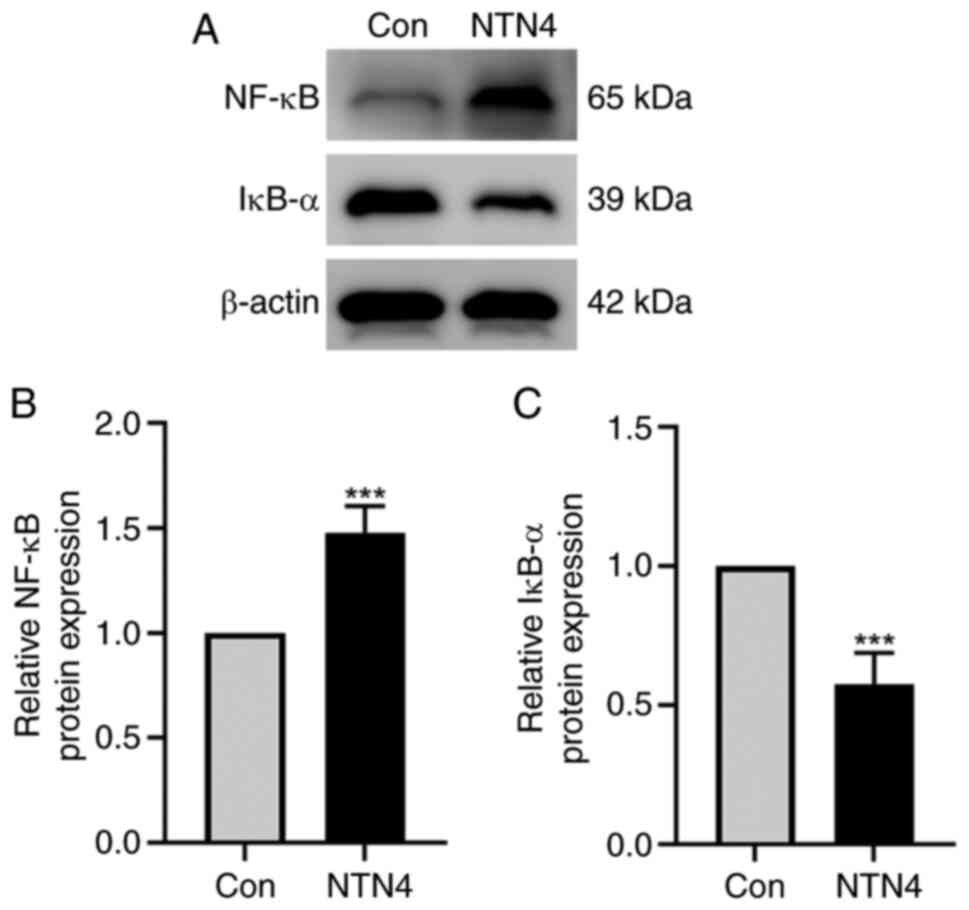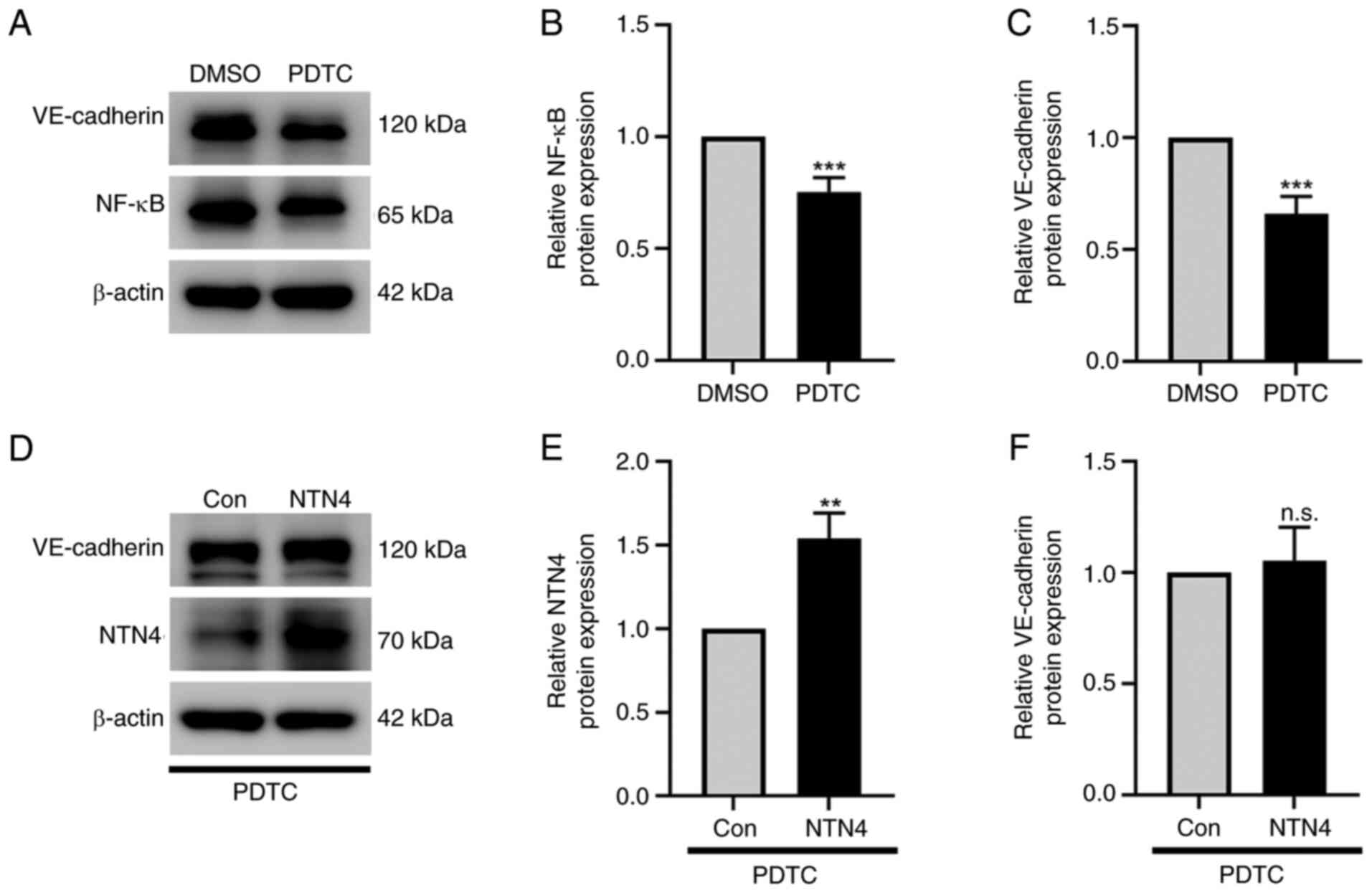Netrin‑4 promotes VE‑cadherin expression in endothelial cells through the NF‑κB signaling pathway
- Authors:
- Published online on: July 4, 2024 https://doi.org/10.3892/etm.2024.12640
- Article Number: 351
-
Copyright: © Zhang et al. This is an open access article distributed under the terms of Creative Commons Attribution License.
Abstract
Introduction
A member of the Netrin family, Netrin-4 (NTN4), is an essential secreted protein present in the vascular endothelium, and is involved in tumor metastasis and brain development (1). NTN4 is present in neural stem cells and contributes to neurite growth in olfactory bulb explants (2). NTN4 mRNA levels in invasive carcinoma of the breast are lower compared with those in surrounding tissues (3). Conversely, increased levels of NTN4 in melanoma are linked to metastasis (4). High NTN4 expression in endothelial cells (ECs) participates in inhibiting endothelial cell migration, promoting EC survival and vascular system formation and is essential for vascular health and stability (5). NTN4 impedes the motility and organization of human microvascular ECs in a controlled laboratory environment (6). NTN4 also fosters blood vessel formation in zebrafish models, with its knockdown leading to notable vascular system defects (7). In addition, exogenous NTN4 stimulates vascular smooth muscle cell adhesion and migration, and exhibits a pro-survival effect (8).
Vascular endothelial (VE)-cadherin, a specialized adhesion protein, resides specifically at the intercellular junctions of ECs (9). VE-cadherin is essential to maintaining vascular integrity, mediating cell-cell adhesion and facilitating signal transduction for angiogenesis and inflammatory responses (10). VE-cadherin maintains endothelial cell morphology and junctions, preserving vascular barrier function through its interaction with β/α-catenin proteins (11). Previous studies have reported the abnormal expression of VE-cadherin in certain aggressive tumors, such as invasive glioma, melanoma and breast cancer (12-14). In addition, suppressing VE-cadherin function inhibits tubule formation in ECs (15). Mice lacking VE-cadherin die mid-gestation due to serious vascular defects (16). As aforementioned, NTN4 also inhibits cell migration, promotes vascular system development and enhances cell survival in ECs. Nevertheless, the regulatory pathway between VE-cadherin and NTN4 has not been investigated.
Several signaling pathways control the expression of VE-cadherin, one of which is the NF-κB pathway (17). NF-κB is a vital transcription factor that plays a key role in cellular processes, inflammation and immune responses (18). IκB-α is a protein that inhibits NF-κB and keeps NF-κB inactive in the cytoplasm (19). Upon receiving activation signals, such as lipopolysaccharide, cytokines, viral protein and oxygen free radicals, IκB-α is degraded, allowing NF-κB to translocate into the cell nucleus and regulate gene transcription (20). NF-κB is involved in the expression of adhesion molecules (such as vascular cell adhesion molecule-1), chemotactic factors and pro-inflammatory cytokines (such as IL-6 and IL-8) in vascular ECs (21). NF-κB binding sites are located in the promoter regions of a number of transcriptional regulatory genes that are expressed in response to inflammatory mediators, such as lipopolysaccharides, IL-1 or TNF-α (22). ECs with suppressed NF-κB activity exhibit reduced VE-cadherin expression and suffer from compromised endothelial barriers (23). This indicates that NF-κB has a multifaceted function in ECs, primarily through regulating VE-cadherin expression.
The present study aimed to investigate whether NTN4 overexpression in ECs could influence cell function and VE-cadherin expression, and whether the NF-κB signaling pathway is involved in this process.
Materials and methods
Cell culture and treatment
HUVECs (CRL-1730) were purchased from the American Type Culture Collection and cultured in DMEM (Gibco; Thermo Fisher Scientific, Inc.), supplemented with 10% FBS (Gibco; Thermo Fisher Scientific, Inc.) and 1% penicillin/streptomycin. The cells were kept at a temperature of 37˚C in a humid environment containing 5% CO2. PDTC powder (Beyotime Institute of Biotechnology) was dissolved in dimethyl sulfoxide (DMSO; Beijing Solarbio Science & Technology Co., Ltd.) at a concentration of 10 mM. For inhibitory experiments, HUVECs were treated with PDTC at a final concentration of 10 µM for 2 h at 37˚C. The control groups were treated with an equal amount of DMSO solution.
Cell transfection
The full length coding sequence of human NTN4 (NM_021229) was synthesized and cloned into GV657 expression vector by GeneChem, Inc. The corresponding empty GV657 plasmid was used as negative control. HUVECs were seeded in 6-well plates and allowed to grow to 50-60% confluency. For each well, 2.5 µg plasmid DNA was incubated at room temperature for 15 min and transfected using Lipofectamine™ 3000 reagent (cat. no. L3000015; Thermo Fisher Scientific, Inc.) according to the manufacturer's instructions. Following 6 h incubation at 37˚C, the culture medium was replaced with fresh media. The cells were harvested for experiments 24 h after transfection.
Cell Counting Kit-8 (CCK-8) assay
Cell viability was measured using the CCK-8 assay kit (cat. no. CA1210; Beijing Solarbio Science & Technology Co., Ltd.), according to the manufacturer's instructions. In brief, cells were seeded in a 96-well plate at a density of 5x10³ per well. On the second day, 10 µl CCK-8 solution was added to each well. After 4 h of incubation, the absorbance was measured on a Multiskan GO spectrophotometer (Thermo Fisher Scientific, Inc.) at 450 nm.
Wound healing assay
HUVECs were seeded in 6-well plates and allowed to grow to 100% confluency. Cells were serum starved for 2 h at 37˚C with 2% FBS medium. The cell monolayer was scratched using a sterile pipette nozzle and washed with PBS to remove debris. Images of six arbitrary fields were captured during the scratch assay at 0 and 24 h in order to measure the scratch area and determine the migration area under a light microscope (Olympus Corporation). Wound healing was analyzed by ImageJ software 1.4.3 (National Institutes of Health). The migration rate was calculated as follows: Migration rate (%)=[(scratch width at 0 h-scratch width at 24 h)/scratch width at 0 h] x100% .
Transwell migration assay
The experiment was carried out using an 8-µm pore Transwell chamber system (Corning, Inc.) in a 24-well plate. HUVECs (5x103 cells/well) were seeded in the upper inserts in 200 µl serum-free DMEM. The lower chamber was filled with 600 µl DMEM containing 5% FBS as a chemoattract to direct cell migration. After 24 h of incubation at 37˚C, the cell inserts were washed with PBS and fixed with 4% formaldehyde solution (1 ml per well) for 30 min at 37˚C. The cells were then stained with 0.1% crystal violet (1 ml per well) at 37˚C for 30 min. The upper chamber was wiped using swabs to remove non-migrated cells and washed with PBS three times. Ultimately, images were captured using an inverted microscope (DMi8; Leica Microsystems, Inc.) at a magnification of x400, and migrated HUVECs were counted manually.
FITC-dextran Transwell assay
The experiment was carried out using a 0.4-µm pore Transwell chamber system (Corning, Inc.) in a 24-well plate. HUVECs (2x104 cells/well) were seeded in the upper inserts in 200 µl DMEM . The lower chamber was filled with 600 µl DMEM supplemented with 10% FBS. When cells grew to 100% confluence, the upper chamber was supplemented with 3 µl 70 kDa FITC-dextran (20 mg/ml; cat. no. FD250S; Sigma-Aldrich; Merck KGaA). After 4 h of incubation at 37˚C, the medium from the lower chamber was transferred into a 96-well plate and measured using a fluorometer (Multiskan GO), at an emission wavelength of 520 nm and an excitation wavelength 485 nm.
Western blotting
HUVECs were rinsed three times with ice-cold PBS and then lysed in RIPA lysis buffer containing 1% protease inhibitor (Beyotime Institute of Biotechnology) for 30 min on ice. The lysates were centrifuged at 15,000 x g at 4˚C for 15 min and the supernatants were collected and used for quantification of total proteins by a BCA protein assay kit (Thermo Fisher Scientific, Inc.). Following heat denaturation at 95˚C for 15 min, the protein samples (15 µg) were separated by SDS-PAGE on 10% polyacrylamide gels and then transferred onto PVDF membranes. Next, 5% non-fat milk was used to block the membrane (Santa Cruz Biotechnology, Inc.) for 2 h at room temperature. Antibodies were diluted in primary antibody dilution buffer (Beyotime Institute of Biotechnology) and incubated overnight at 4˚C. The following primary antibodies were used: Rabbit anti-NF-κB p65 (1:1,000, cat. no. 8242; Cell Signaling Technology, Inc.), mouse anti-NTN4 (1:1,000, cat. no. MAB1254; R&D Systems, Inc.), rabbit anti-VE-cadherin (1:1,000, cat. no. ab33168; Abcam) and mouse anti-IκB-α (1:1,000, cat. no. 4814; Cell Signaling Technology, Inc.). β-actin (1:10,000, 20536-1-AP, Proteintech Group, Inc.) was used as the loading control. The membranes were incubated with HRP-conjugated secondary antibodies: Goat Anti-Rabbit IgG (111-035-003, Jackson ImmunoResearch Laboratories, Inc) and Goat anti-Mouse IgG (both 1:10,000, 115-035-003, Jackson ImmunoResearch Laboratories, Inc) at room temperature for 2 h. Immunoblots were visualized using Immobilon Western Chemiluminescent HRP substrate (MilliporeSigma) on a Bio-Rad imaging system (Bio-Rad Laboratories, Inc.). Densitometry was performed using ImageJ version 1.8.
Reverse transcription-quantitative PCR (RT-qPCR)
RNA was isolated from HUVECs using TRIzol® reagent from Invitrogen (Thermo Fisher Scientific, Inc.). Subsequently, cDNA synthesis and amplification were performed using the HiScript® III RT Super Mix (cat. no. R323-01; Vazyme Biotech, Co., Ltd.). The RT procedure was: 2 min at 42˚C, 15 min at 37˚C, 5 sec at 85˚C and the 30 min at 4˚C. For RT-qPCR analysis, ChamQ Universal SYBR qPCR Master Mix (cat. no. Q711-02; Vazyme Biotech, Co., Ltd.) was used. The thermocycling conditions were as follows: 95˚C for 30 sec, 40 cycles at 95˚C for 10 sec and 60˚C for 30 sec. The internal reference gene used was GAPDH. The relative expression levels of the target genes were measured using the 2-ΔΔCq method (24). The following primer sequences (5'-3') were used: GAPDH forward, GGAGCGAGATCCCTCCAAAAT and reverse, GGCTGTTGTCATACTTCGCATGG; NTN4 forward, ACACTCAGGTAAATGCGAATGT and reverse, ACCTTTTTAATCTTCACATTGACCT; VE-cadherin forward, GCGACTACCAGGACGCTTTCA and reverse, CATGTATCGGAGGTCGATGGTG.
Statistical analysis
GraphPad Prism 5.0 (GraphPad; Dotmatics) was used for statistical analysis. All data are presented as the mean ± SD, unless otherwise stated. Each experiment was performed at least three times independently, and statistical significance was calculated using an unpaired Student's t-test. P<0.05 was considered to indicate a statistically significant difference.
Results
NTN4 overexpression reduces HUVEC viability
HUVECs were transfected with control and NTN4-overexpressing plasmid. NTN4 expression was validated using western blotting and RT-qPCR. NTN4 mRNA expression was significantly increased in NTN4-overexpressing HUVECs (Fig. 1A). NTN4 protein levels were also markedly higher in NTN4-overexpressing HUVECs (Fig. 1B). In addition, densitometry of protein bands showed a significant increase in NTN4 expression in NTN4-overexpressing HUVECs compared with the control group (Fig. 1C). To test the role of NTN4 in HUVEC viability, cells were subjected to a CCK-8 assay following transfection with control or NTN4-overexpressing plasmids. The findings showed that cell viability was significantly lower in NTN4-overexpressing HUVECs compared with that in the control group (Fig. 1D). Therefore, NTN4 overexpression was shown to inhibit HUVEC cell viability.
NTN4 overexpression reduces HUVEC migration
To assess the effect of NTN4 overexpression on HUVEC migration, wound healing and Transwell assays were performed. Relative cell migration of NTN4-overexpressing cells was significantly reduced at ~50% of that in the control group (Fig. 2A and B). In the Transwell assay, the number of HUVECs that migrated from the top to the lower chamber was significantly lower in the NTN4-overexpressing group compared with that in the control group (Fig. 2C and D). Overall, NTN4 overexpression in HUVECs resulted in impaired migration in both wound healing experiments and Transwell assays.
NTN4 overexpression increases the expression of VE-cadherin in HUVECs and reduces the permeability of HUVECs
HUVECs were transfected with control and NTN4-overexpressing plasmids to assess the impact of NTN4 overexpression on VE-cadherin expression level and permeability. RT-qPCR results demonstrated a significant increase in VE-cadherin mRNA levels in HUVECs transfected with the NTN4-overexpressing plasmid compared with that in the control group (Fig. 3A). The western blotting results revealed an increase in the VE-cadherin protein expression level in HUVECs after NTN4 overexpression (Fig. 3B). In addition, densitometry of protein bands revealed a significant difference in VE-cadherin expression between the two groups (Fig. 3C). VE-cadherin controls the adhesion of vascular ECs, which helps to preserve the integrity and permeability of the vascular endothelial layer (25). Therefore, the present study measured the permeability of cell monolayers using a FITC-dextran Transwell assay. The FITC-dextran migration was significantly reduced in cells with NTN4 overexpression compared with the control (Fig. 3D). As a result, overall, NTN4 overexpression increased VE-cadherin expression levels and decreased HUVEC permeability.
NTN4 overexpression increases NF-κB and decreases IκB-α protein expression in HUVECs
HUVECs were transfected with control and NTN4-overexpressing plasmids, and the protein expression of NF-κB and IκB-α was assessed using western blotting. The findings indicated a reduction in IκB-α protein expression and an increase in NF-κB protein expression in the NTN4-overepxression group (Fig. 4A). Densitometry of protein bands showed significant difference in both NF-κB and IκB-α expression between the two groups (Fig. 4B and C). Thus, in HUVECs, NTN4 overexpression caused a decrease in IκB-α protein expression and an increase in NF-κB protein expression.
In HUVECs treated with NF-κB inhibitor PDTC, NTN4 overexpression does not alter VE-cadherin expression
The protein expression of VE-cadherin, NTN4 and NF-κB was determined in HUVECs treated with PDTC using western blotting. PDTC significantly suppressed NF-κB (Fig. 5A and B) and VE-cadherin expression (Fig. 5A and C) in normal HUVECs at a dose of 10 µM compared with the DMSO-treated control. The intensity of protein bands was evaluated by normalizing them to β-actin (Fig. 5B and C). However, when NTN4 was significantly overexpressed in HUVECs treated with the NF-κB inhibitor PDTC (Fig. 5D and E), VE-cadherin protein expression was not significantly different compared with the control group (Fig. 5D and F). The protein band intensities were measured in relation to β-actin to evaluate the expression levels of VE-cadherin and NTN4 (Fig. 5E and F). According to these findings, NTN4 overexpression stimulated the NF-κB signaling pathway, which in turn induced the expression of VE-cadherin in HUVECs.
Discussion
In the present study, an NTN4-overexpression plasmid was transfected into HUVECs to induce NTN4 overexpression. HUVEC migration and cell viability were inhibited by NTN4 overexpression. Furthermore, overexpression of NTN4 resulted in decreased HUVEC permeability and increased VE-cadherin expression. Subsequent investigations showed that NTN4 overexpression increased NF-κB protein expression and decreased IκB-α protein expression in HUVECs. In HUVECs treated with NF-κB inhibitor PDTC, NTN4 overexpression did not cause a change in the expression of VE-cadherin.
The Netrin family member NTN4, which is highly conserved, is essential for healthy vascular function, tumor growth and neural development (1). For instance, a previous study showed that NTN4 overexpression prevents clear cell renal cell carcinoma growth (26). In breast cancer cells, NTN4 overexpression leads to reduced migration and invasion rates (27). In addition, diminishing NTN4 reduces EC permeability (5). In line with the aforementioned findings, the present study revealed that NTN4 overexpression inhibited the migration and viability of HUVECs and reduced their permeability.
VE-cadherin maintains intercellular adhesion and structural integrity between vascular ECs. In addition, VE-cadherin regulates cellular dynamics including migration, proliferation and permeability (28). The phosphorylation of VE-cadherin results in VE-cadherin internalization into clathrin-coated vesicles and the consequent disassembly from intercellular junctions. This is another route for VE-cadherin to regulate endothelial permeability (25). VE-cadherin is regulated by vascular endothelial growth factor (VEGF). VEGF induces VE-cadherin to internalize fast, endangering the integrity of the endothelial barrier (25). Furthermore, in human cells, the VE-cadherin promoter is actively suppressed by the transcription factor Slug (29). In addition, bone morphogenetic protein 6 controls the internalization of VE-cadherin, which increases the permeability of human ECs (30). Furthermore, the NF-κB signaling pathway, which is necessary for the inhibition of apoptosis and the promotion of cell survival, modulates VE-cadherin (23,31). IκB-α functions as a protein that inhibits the NF-κB signaling pathway (19). The speed of endothelial barrier collapse increases when VE-cadherin levels are significantly reduced, which is associated with the blocking of NF-κB (23). However, the relationship between NTN4 and VE-cadherin has not yet been studied. The present study revealed that NTN4 overexpression increased VE-cadherin expression in HUVECs, suggesting a novel way to modulate VE-cadherin.
NF-κB triggers the transcription of multiple genes linked to inflammation, resulting in the control of cell adhesion and survival (32). Concurrently, the PI3K/AKT pathway is activated by the interaction of NTN4 with integrin β4(33). The NF-κB signaling pathway is triggered by the AKT pathway, which increases cell survival (34). A previous study has indicated that NTN4 improves endothelial cell survival in a way that is dependent on time and dosage (35). These results suggest a synergistic interaction among NTN4, the PI3K/AKT pathway and NF-κB signaling. Furthermore, NTN4 and NF-κB serve roles in preserving endothelial permeability. NF-κB increases the expression of adhesion molecules, enhancing the adhesiveness and permeability of ECs (36). Through integrins α2β1 and α3β1, endothelium-derived NTN4 promotes pancreatic epithelial cell adhesion (37). The present study showed that overexpressing NTN4 in the HUVECs led to significantly increased levels of NF-κB and significantly decreased levels of IκB-α, suggesting the activation of the NF-κB signaling pathway. Moreover, VE-cadherin expression was not induced by NTN4 overexpression in HUVECs treated with NF-κB inhibitors. Therefore, the present study demonstrated that NTN4 overexpression increased VE-cadherin expression levels in a NF-κB signaling-dependent manner.
In conclusion, the present study provided evidence that the NTN4 overexpression decreased endothelial cell viability and migration. Furthermore, the present study revealed a novel role of NTN4 in the regulation of VE-cadherin expression and related mechanism, as well as the protection of endothelial barrier integrity by NTN4. These findings provided a novel regulatory mechanism of VE-cadherin expression, as well as a direction for future studies to investigate the role of NTN4 in endothelial barrier-related diseases. Nevertheless, nuclear NF-κB data and in vivo data are lacking due to time constraints. These limitations should be further addressed in future investigations.
Acknowledgements
Not applicable.
Funding
Funding: The present study was supported by the Natural Science Foundation of Shandong Province (grant no. ZR2020MH181) and National Natural Science Foundation of China (grant no. 82171318).
Availability of data and materials
The data generated in the present study may be requested from the corresponding author.
Authors' contributions
DZ contributed to the experimental design, acquisition of data and data analysis. ZZ and KW contributed to the writing and editing of the manuscript, as well as the analysis and interpretation of the data. SZ and JL contributed to the conception, experimental design, acquisition of data, data analysis, and the writing and editing of the manuscript. DZ, SZ and JL confirm the authenticity of all the raw data. All authors read and approved the final manuscript.
Ethics approval and consent to participate
Not applicable.
Patient consent for publication
Not applicable.
Competing interests
The authors declare that they have no competing interests.
References
|
Dong F, Liu Y, Yan W, Meng Q, Song X, Cheng B and Yao R: Netrin-4: Focus on its role in axon guidance, tissue stability, angiogenesis and tumors. Cell Mol Neurobiol. 43:1663–1683. 2023.PubMed/NCBI View Article : Google Scholar | |
|
Koch M, Murrell JR, Hunter DD, Olson PF, Jin W, Keene DR, Brunken WJ and Burgeson RE: A novel member of the netrin family, β-Netrin, shares homology with the β chain of laminin: Identification, expression, and functional characterization. J Cell Biol. 151:221–234. 2000.PubMed/NCBI View Article : Google Scholar | |
|
Yi L, Lei Y, Yuan F, Tian C, Chai J and Gu M: NTN4 as a prognostic marker and a hallmark for immune infiltration in breast cancer. Sci Rep. 12(10567)2022.PubMed/NCBI View Article : Google Scholar | |
|
Bruikman CS, Zhang H, Kemper AM and van Gils JM: Netrin family: Role for protein isoforms in Cancer. J Nucleic Acids. 2019(3947123)2019.PubMed/NCBI View Article : Google Scholar | |
|
Zhang H, Vreeken D, Leuning DG, Bruikman CS, Junaid A, Stam W, de Bruin RG, Sol WMPJ, Rabelink TJ, van den Berg BM, et al: Netrin-4 expression by human endothelial cells inhibits endothelial inflammation and senescence. Int J Biochem Cell Biol. 134(105960)2021.PubMed/NCBI View Article : Google Scholar | |
|
Nacht M, St Martin TB, Byrne A, Klinger KW, Teicher BA, Madden SL and Jiang Y: Netrin-4 regulates angiogenic responses and tumor cell growth. Exp Cell Res. 315:784–794. 2009.PubMed/NCBI View Article : Google Scholar | |
|
Lambert E, Coissieux MM, Laudet V and Mehlen P: Netrin-4 acts as a pro-angiogenic factor during zebrafish development. J Biol Chem. 287:3987–3999. 2012.PubMed/NCBI View Article : Google Scholar | |
|
Lejmi E, Bouras I, Camelo S, Roumieux M, Minet N, Leré-Déan C, Merkulova-Rainon T, Autret G, Vayssettes C and Clement O: Netrin-4 promotes mural cell adhesion and recruitment to endothelial cells. Vasc Cell. 6(1)2014.PubMed/NCBI View Article : Google Scholar | |
|
Aman J and Margadant C: Integrin-dependent cell-matrix adhesion in endothelial health and disease. Circ Res. 132:355–378. 2023.PubMed/NCBI View Article : Google Scholar | |
|
Lampugnani MG, Dejana E and Giampietro C: Vascular endothelial (VE)-cadherin, endothelial adherens junctions, and vascular disease. Cold Spring Harb Perspect Biol. 10(a029322)2018.PubMed/NCBI View Article : Google Scholar | |
|
Vestweber D: VE-cadherin: The major endothelial adhesion molecule controlling cellular junctions and blood vessel formation. Arterioscler Thromb Vasc Biol. 28:223–232. 2008.PubMed/NCBI View Article : Google Scholar | |
|
Boda-Heggemann J, Régnier-Vigouroux A and Franke WW: Beyond vessels: Occurrence and regional clustering of vascular endothelial (VE-)cadherin-containing junctions in non-endothelial cells. Cell Tissue Res. 335:49–65. 2009.PubMed/NCBI View Article : Google Scholar | |
|
Hendrix MJC, Seftor EA, Meltzer PS, Gardner LM, Hess AR, Kirschmann DA, Schatteman GC and Seftor RE: Expression and functional significance of VE-cadherin in aggressive human melanoma cells: Role in vasculogenic mimicry. Proc Natl Acad Sci USA. 98:8018–8023. 2001.PubMed/NCBI View Article : Google Scholar | |
|
Martin TA, Watkins G, Lane J and Jiang WG: Assessing microvessels and angiogenesis in human breast cancer, using VE-cadherin. Histopathology. 46:422–430. 2005.PubMed/NCBI View Article : Google Scholar | |
|
Navaratna D, Maestas J, McGuire PG and Das A: Suppression of retinal neovascularization with an antagonist to vascular endothelial cadherin. Arch Ophthalmol. 126:1082–1088. 2008.PubMed/NCBI View Article : Google Scholar | |
|
Gory-Fauré S, Prandini MH, Pointu H, Roullot V, Pignot-Paintrand I, Vernet M and Huber P: Role of vascular endothelial-cadherin in vascular morphogenesis. Development. 126:2093–2102. 1999.PubMed/NCBI View Article : Google Scholar | |
|
Hou Y, Li F, Karin M and Ostrowski MC: Analysis of the IKKbeta/NF-kappaB signaling pathway during embryonic angiogenesis. Dev Dyn. 237:2926–2935. 2008.PubMed/NCBI View Article : Google Scholar | |
|
Liu T, Zhang L, Joo D and Sun SC: NF-κB signaling in inflammation. Signal Transduct Target Ther. 2(17023)2017.PubMed/NCBI View Article : Google Scholar | |
|
Sun Z and Andersson R: NF-kappaB activation and inhibition: A review. Shock. 18:99–106. 2002.PubMed/NCBI View Article : Google Scholar | |
|
Wang X, Peng H, Huang Y, Kong W, Cui Q, Du J and Jin H: Post-translational modifications of IκBα: The state of the art. Front Cell Dev Biol. 8(574706)2020.PubMed/NCBI View Article : Google Scholar | |
|
Sprague AH and Khalil RA: Inflammatory cytokines in vascular dysfunction and vascular disease. Biochem Pharmacol. 78:539–552. 2009.PubMed/NCBI View Article : Google Scholar | |
|
Martin Rd, Hoeth M, Hofer-Warbinek R and Schmid JA: The transcription factor NF-κB and the regulation of vascular cell function. Arterioscler Thromb Vasc Biol. 20:E83–E88. 2000.PubMed/NCBI View Article : Google Scholar | |
|
Colás-Algora N, García Weber D, Cacho-Navas C, Barroso S, Caballero A, Ribas C, Correas I and Millán J: Compensatory increase of VE-cadherin expression through ETS1 regulates endothelial barrier function in response to TNFα. Cell Mol Life Sci. 77:2125–2140. 2020.PubMed/NCBI View Article : Google Scholar | |
|
Livak KJ and Schmittgen TD: Analysis of relative gene expression data using real-time quantitative PCR and the 2(-Delta Delta C(T)) method. Methods. 25:402–408. 2001.PubMed/NCBI View Article : Google Scholar | |
|
Giannotta M, Trani M and Dejana E: VE-cadherin and endothelial adherens junctions: Active guardians of vascular integrity. Dev Cell. 26:441–454. 2013.PubMed/NCBI View Article : Google Scholar | |
|
Ke S and Guo J, Wang Q, Shao H, He M, Li T, Qiu T and Guo J: Netrin family genes as prognostic markers and therapeutic targets for clear cell renal cell carcinoma: Netrin-4 acts through the Wnt/β-catenin signaling pathway. Cancers (Basel). 15(2816)2023.PubMed/NCBI View Article : Google Scholar | |
|
Yang H, Ting X, Geng YH, Xie Y, Nierenberg JL, Huo YF, Zhou YT, Huang Y, Yu YQ, Yu XY, et al: The risk variant rs11836367 contributes to breast cancer onset and metastasis by attenuating Wnt signaling via regulating NTN4 expression. Sci Adv. 8(eabn3509)2022.PubMed/NCBI View Article : Google Scholar | |
|
Gavard J and Gutkind JS: VEGF controls endothelial-cell permeability by promoting the beta-arrestin-dependent endocytosis of VE-cadherin. Nat Cell Biol. 8:1223–1234. 2006.PubMed/NCBI View Article : Google Scholar | |
|
Hultgren NW, Fang JS, Ziegler ME, Ramirez RN, Phan DTT, Hatch MMS, Welch-Reardon KM, Paniagua AE, Kim LS, Shon NN, et al: Slug regulates the Dll4-Notch-VEGFR2 axis to control endothelial cell activation and angiogenesis. Nat Commun. 11(5400)2020.PubMed/NCBI View Article : Google Scholar | |
|
Benn A, Bredow C, Casanova I, Vukičević S and Knaus P: VE-cadherin facilitates BMP-induced endothelial cell permeability and signaling. J Cell Sci. 129:206–218. 2016.PubMed/NCBI View Article : Google Scholar | |
|
Ma B and Hottiger MO: Crosstalk between Wnt/β-Catenin and NF-κB signaling pathway during Inflammation. Front Immunol. 7(378)2016.PubMed/NCBI View Article : Google Scholar | |
|
Zhang T, Ma C, Zhang Z, Zhang H and Hu H: NF-κB signaling in inflammation and cancer. MedComm (2020). 2:618–653. 2021.PubMed/NCBI View Article : Google Scholar | |
|
Hu Y, Ylivinkka I, Li L, Chen P, Hautaniemi S, Nyman TA, Keski-Oja JKO and Hyytiäinen M: Abstract 3348: Netrin-4/Integrin beta-4 interaction promotes glioblastoma cell proliferation and protects from temozolomide induced cellular senescence via activating PI3K/AKT pathway. Cancer Res. 74:3348. 2014. | |
|
Kane LP, Shapiro VS, Stokoe D and Weiss A: Induction of NF-κB by the Akt/PKB kinase. Curr Biol. 9:601–604. 1999.PubMed/NCBI View Article : Google Scholar | |
|
Larrieu-Lahargue F, Welm AL, Thomas KR and Li DY: Netrin-4 induces lymphangiogenesis in vivo. Blood. 115:5418–5426. 2010.PubMed/NCBI View Article : Google Scholar | |
|
Singh V, Kaur R, Kumari P, Pasricha C and Singh R: ICAM-1 and VCAM-1: Gatekeepers in various inflammatory and cardiovascular disorders. Clin Chim Acta. 1(117487)2023.PubMed/NCBI View Article : Google Scholar | |
|
Yebra M, Diaferia GR, Montgomery AM, Kaido T, Brunken WJ, Koch M, Hardiman G, Crisa L and Cirulli V: Endothelium-derived Netrin-4 supports pancreatic epithelial cell adhesion and differentiation through integrins α2β1 and α3β1. PLoS One. 6(e22750)2011.PubMed/NCBI View Article : Google Scholar |



